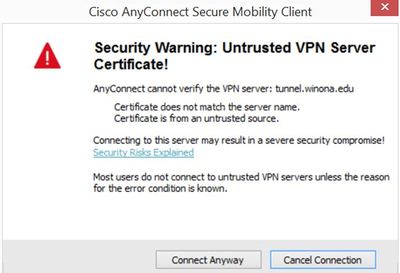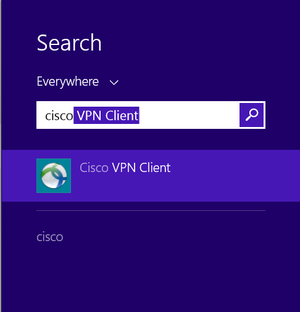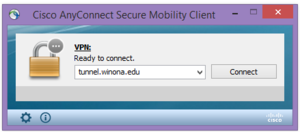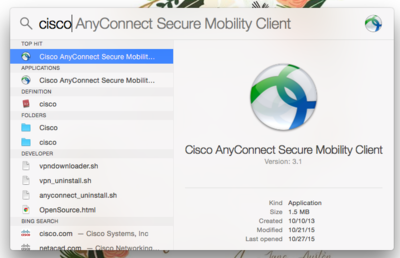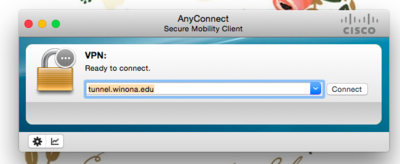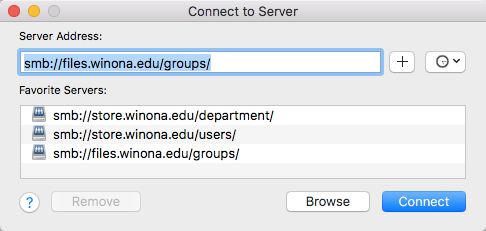Difference between revisions of "VPN"
| Line 1: | Line 1: | ||
{{TOC_Float_Right}} | {{TOC_Float_Right}} | ||
==About this Article== | ==About this Article== | ||
| − | '''VPN''' stands for Virtual Private Network. | + | '''VPN''' stands for Virtual Private Network. Cisco AnyConnect can be used to connect to the WSU network when you are off-campus. This software is available to both '''Students''' and '''Employees.''' |
==Cisco AnyConnect VPN client== | ==Cisco AnyConnect VPN client== | ||
| − | Using the Cisco AnyConnect VPN client software, you can connect a WSU laptop to the WSU [[network]] from off campus. This | + | Using the Cisco AnyConnect VPN client software, you can connect a WSU laptop to the WSU [[network]] from off-campus. This connection enables the same network access you have while on-campus. The data is encrypted to preserve security. This includes: |
| − | *Network storage drives (e.g., personal, class, departmental) Note: See instructions below to Map Network Drives | + | *Network storage drives (e.g., personal, class, departmental storage) Note: See instructions below to connect to these types of storage via the 'Map Network Drives' shortcut. |
| − | |||
| − | == | + | ==Accessing the Cisco AnyConnect VPN Software== |
| − | NOTE: | + | NOTE: You may see this error a couple times while trying to connect. Click on "Connect anyway". |
[[File:VPN_error.jpg|400 px]] | [[File:VPN_error.jpg|400 px]] | ||
| − | === | + | ===Windows 10=== |
* From the Windows Start Screen | * From the Windows Start Screen | ||
* Use the Search icon | * Use the Search icon | ||
| Line 21: | Line 20: | ||
* You will be prompted to Connect and login to WSU with your StarID and password. | * You will be prompted to Connect and login to WSU with your StarID and password. | ||
| − | === | + | ===Windows 8.1=== |
* From the Windows Start Screen | * From the Windows Start Screen | ||
* Search "Cisco" | * Search "Cisco" | ||
| Line 30: | Line 29: | ||
* Use your StarID and password to login | * Use your StarID and password to login | ||
| − | === | + | ===macOS=== |
* Click on Spotlight in the upper right corner | * Click on Spotlight in the upper right corner | ||
| Line 57: | Line 56: | ||
* Finish | * Finish | ||
| − | ''' | + | '''macOS''' |
* Use the Finder | * Use the Finder | ||
* Go | * Go | ||
* Connect to Server | * Connect to Server | ||
| − | * Server address for Employees to get to personal storage: smb://store.winona.edu/users/ | + | * Server address for Employees to get to personal storage: smb://store.winona.edu/users/yourStarIDhere |
* Server address for Employees to get to department drive: smb://store.winona.edu/department | * Server address for Employees to get to department drive: smb://store.winona.edu/department | ||
| − | ==Map Network Drives Continued | + | ==Map Network Drives (Continued)== |
| − | If you want to connect to Personal Network or Department Network drives from off-campus, you will need to VPN | + | If you want to connect to Personal Network or Department Network drives from off-campus, you will need to connect to VPN before you can use the network drives. |
| − | '''Windows | + | '''Windows 10''' |
| − | * | + | * Open the Start Menu then select the '''Map Network Drives''' shortcut. |
| − | * A | + | * A black window will appear and map your drives. Do not close this window. |
| − | * | + | * Double-click 'This PC' on your desktop to access your network drives (See Fig 1.) |
| + | * Do not disconnect VPN or WiFi during use. Network access is required to maintain the VPN connection. | ||
[[File:ConnectToServer.png|frame|Fig 2. Typical list of network connections on a MacBook]] | [[File:ConnectToServer.png|frame|Fig 2. Typical list of network connections on a MacBook]] | ||
| − | ''' | + | '''macOS''' |
* In Finder, hold down '''<CommandKey>''' then hit the '''<K>''' key to bring up "Connect to Server" | * In Finder, hold down '''<CommandKey>''' then hit the '''<K>''' key to bring up "Connect to Server" | ||
| − | * Mac users connect to one of the network locations listed in | + | * Mac users connect to one of the network locations listed in Fig 2. |
==Related information== | ==Related information== | ||
Revision as of 20:13, 29 October 2018
About this Article
VPN stands for Virtual Private Network. Cisco AnyConnect can be used to connect to the WSU network when you are off-campus. This software is available to both Students and Employees.
Cisco AnyConnect VPN client
Using the Cisco AnyConnect VPN client software, you can connect a WSU laptop to the WSU network from off-campus. This connection enables the same network access you have while on-campus. The data is encrypted to preserve security. This includes:
- Network storage drives (e.g., personal, class, departmental storage) Note: See instructions below to connect to these types of storage via the 'Map Network Drives' shortcut.
Accessing the Cisco AnyConnect VPN Software
NOTE: You may see this error a couple times while trying to connect. Click on "Connect anyway".
Windows 10
- From the Windows Start Screen
- Use the Search icon
- Search for Cisco
- Select 'Cisco AnyConnect Secure Mobility Client'
- You will be prompted to Connect and login to WSU with your StarID and password.
Windows 8.1
- From the Windows Start Screen
- Search "Cisco"
- Select "Cisco VPN Client"
- Choose Connect in the menu below:
- Use your StarID and password to login
macOS
- Click on Spotlight in the upper right corner
- Type in "Cisco"
- Select "Cisco AnyConnect Secure Mobility Client"
- Connect to Tunnel.winona.edu
- Use your StarID and password when prompted to login
Map Network Drives
Mapping network storage for Employees
Windows 10
You will need to manually map your Personal Network Storage also referred to as R: drive.
- Open File Explorer from the Taskbar
- Use the drop down arrow in the top menu for 'Map network drive' and select Map network drive
- Type the following in Folder: \\store\users\(your StarID)
- Select 'Reconnect at sign-in'
- Finish
macOS
- Use the Finder
- Go
- Connect to Server
- Server address for Employees to get to personal storage: smb://store.winona.edu/users/yourStarIDhere
- Server address for Employees to get to department drive: smb://store.winona.edu/department
Map Network Drives (Continued)
If you want to connect to Personal Network or Department Network drives from off-campus, you will need to connect to VPN before you can use the network drives.
Windows 10
- Open the Start Menu then select the Map Network Drives shortcut.
- A black window will appear and map your drives. Do not close this window.
- Double-click 'This PC' on your desktop to access your network drives (See Fig 1.)
- Do not disconnect VPN or WiFi during use. Network access is required to maintain the VPN connection.
macOS
- In Finder, hold down <CommandKey> then hit the <K> key to bring up "Connect to Server"
- Mac users connect to one of the network locations listed in Fig 2.
